Green Roof System
A blog on Green Roof System.
The Green Roof System also known by other names like the eco-roof, living roof, roof garden & vegetated roof, is a system of growing plants or vegetation on the roof with the help of certain roof protection layers. This is different from growing plants in containers on top of the roof, which is not considered a green roof system. Green roof systems help restore habitats in urban environments.
A green roof promotes not only biodiversity in the city but also purifies the air, lowers the ambient temperature, regulates indoor temperatures, and conserves energy too. Humans, as well as animals, are happier in a green environment than in a dry environment.
Types of Green Roof Systems
Depending on the specific use case, builders can opt for any of the three different types of green roof systems available:
a) Intensive Green Roof System
An intensive green roof system offers great potential for biodiversity and can be used for planting medium plants, small trees, and even medium shrubs. Here a soil thickness between 10" to 15" is available for the plants. The initial investment is higher and it’s heavier than the other two systems. This system also requires more maintenance.
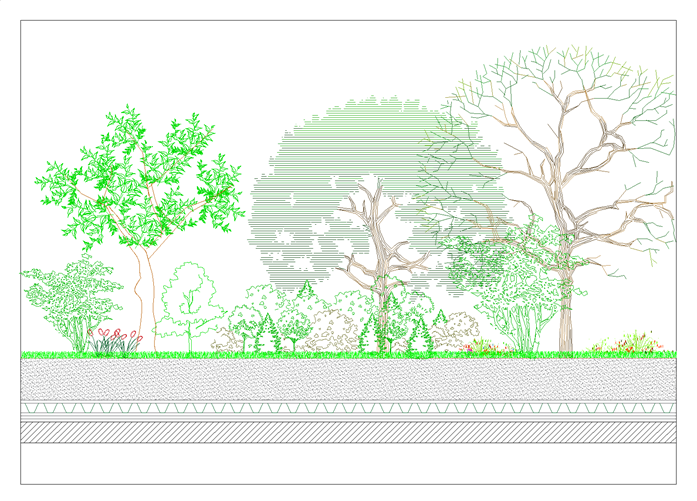
b) Semi-Intensive Green Roof System
It’s an intermediate system between intensive and extensive systems. A semi-intensive green roof system can handle a soil height between 6" to 8" and can be used to plant medium shrubs, tall grasses, and plants of medium height. Semi Intense green roofs offer great potential for biodiversity but the initial investment is higher. This system also requires more maintenance.
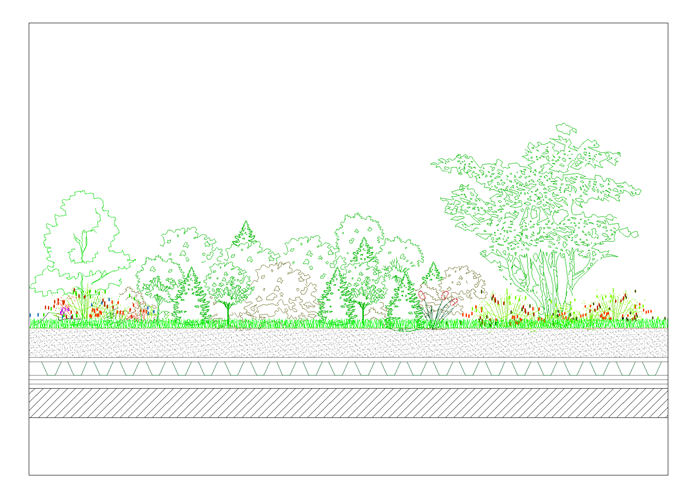
c) Extensive Green Roof System
Extensive green roof systems are very cost-efficient and lightweight compared to the other two systems. These systems support soil heights up to 4” and can be used to plant succulents, small plants, and grasses. The system requires less maintenance and is the cheapest among all the green roof systems.
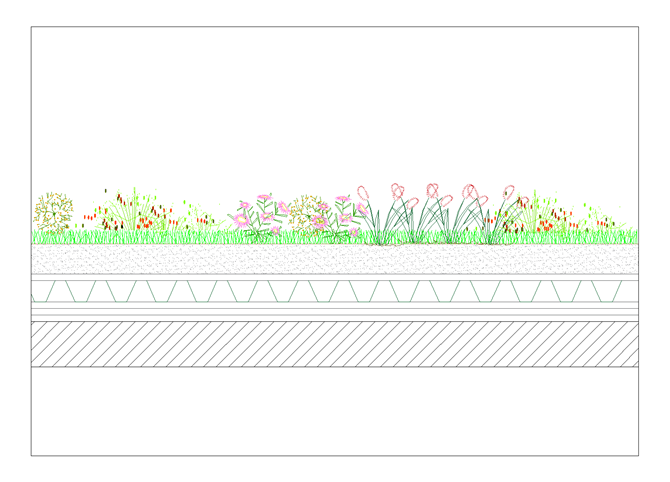
What are the steps for implementing a green roof?
Installing a green roof over a building usually follows these steps.
Study the load-bearing capacity of the building
Load-bearing capacity has an important role in the green roof system. So before planning it’s important to get the roof reviewed by a structural engineer. To explore the different green roof solutions, it is important to understand the amount of weight the roof can support as well as the role of wind and wind velocity.
Planning
In this step, the space available for the green roof systems is measured and the required materials and plants are selected.
Design
In this step, the entire system and the space are designed in 2D/3D.
Installation
The time and money involved in the installation depend on the space and size involved as well as the type of green roof used.
Installation Steps:
Step 1 – Waterproofing on top of the roof.
Step 2 – Installing root barrier.
Step 3 – Installing the protection layer.
Step 4 – Installing drainage layer.
Step 5 – Installing filter layer.
Step 6 – Growing Substrate.
Step 7 – Planting Seeds or vegetation layer.
Maintenance:
This step involves the care involved after installation.
Layers of Green Roof System
a) Roof
Not all roof constructions are suitable for supporting a green roof. Concrete roofs provide the most stable structure but it is possible to install a green roof on metal, plastic, and gypsum roof structures as well. Flat roofs can be easily converted into green roofs system.
b) Waterproofing membrane
This layer is for protecting the roof from water penetration. Either the Ethylene propylene diene monomer (EPDM) membrane or the Butyl rubber membrane is used for this layer.
c) Root barrier
To protect the waterproofing membrane, a root barrier with a thickness of at least 2.5mm is used. Either high-density polyethylene (HDPE) or high-density polypropylene is used here.
d) Protection layer
The protection layer protects the inner membrane and helps retain water and manure.
e) Drainage layer
Helps to retain the remaining water after soaking. It helps when the plants need water.
f) Filter layer
Protect the drainage layer from small particles that block the drainage hole.
g) Soil
A mixture of garden soil, gravel & cocopeat.
h) Planting
Depend upon the types of the green roof system.
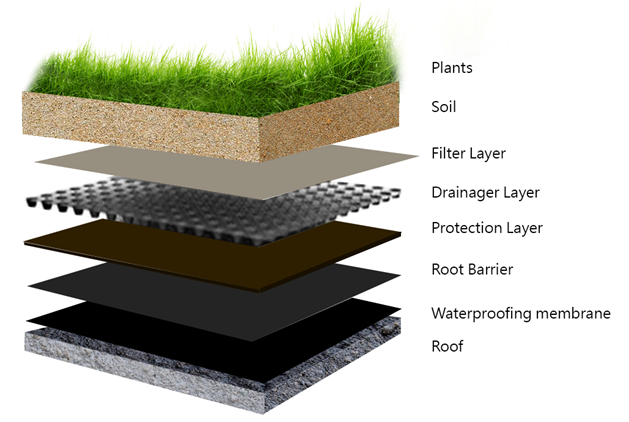
Advantages of green roof system
- It is possible to reduce the use of fans and air-conditioning.
- A green roof system can reduce the amount of rainwater leaving the roof to some extent. With temporary storage, the supply of water to local sewage systems during heavy or prolonged rainfall can be delayed and the possibility of flooding can be reduced.
- Prevents heat escape in winter seasons, resulting in lower heating costs for the building.
- Reduces air pollution
- Increase the life of the roof, as the vegetation prevents damage from solar radiation.
- Reduces smog and improves air quality.
- Reduces the impact of carbon monoxide
- Provides habitat for wildlife.
- Contributes to biodiversity and creates habitats.
Disadvantages of green roof system
- The initial cost of installation is high.
- Insects can easily infiltrate a building through open windows.
- For intensive green roofs, there is an additional cost for reinforcing the building.
- Based on the green roof types, the cost of installation and maintenance could be high.
Conclusion
Green roofs play an important role in urban architecture. They help to reduce air pollution and improve living standards in cities. Green roofs should be considered when planning your next buildings.


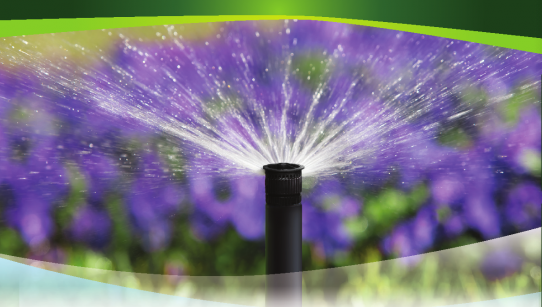


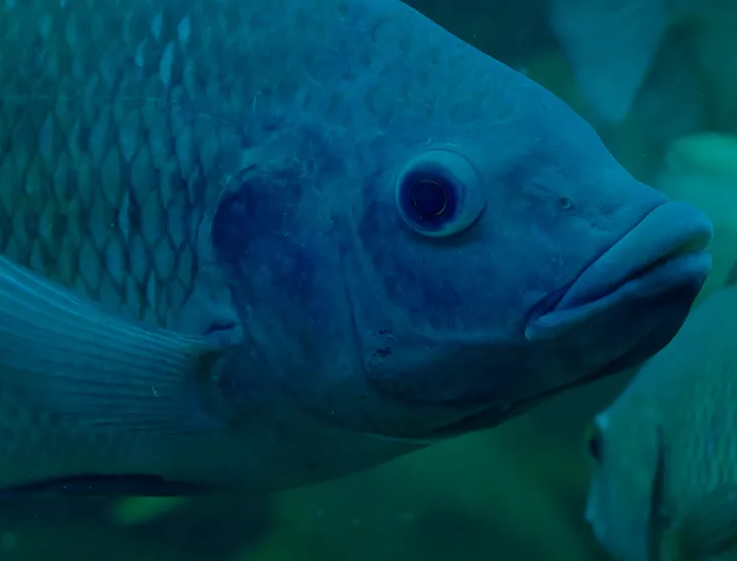

.png)




Comments (2)
Thanks for your feedback. Well, there are constraints on using green-roofs, we can't use it in every situation
Too bad MEGA itself didn't follow this sensible advice and when for a tin roof.